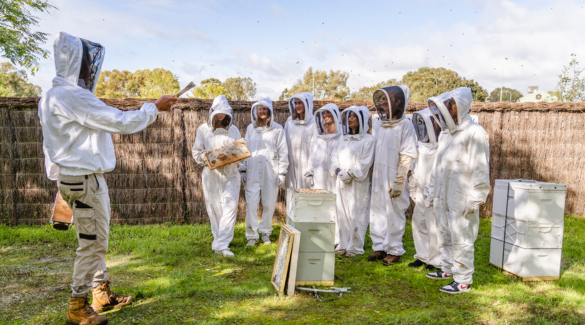Everything you need to know before you set up your beehive.
Beekeeping is getting more and more popular as people want to “get up close and personal” with nature. There is also much interest globally to protect and save the bees … so what is involved and do bees make good pets?
Beekeeping Snapshot
“I mean, really, what is involved you ask yourself? Is it like keeping a cat or a dog?”, well the answer is no.
Bees have requirements and to look after them and you need somewhere to put them where there are lots of flowering plants and you will have to monitor them regularly to keep them happy and healthy.

Where to start?
Start with a book to see what is involved. It can be daunting, but it is a lot of fun getting to know how to keep bees, and to find out what sort of hives you can house them in as well as where you can legally put them. Firstly, you have to check with your shire to know if you can keep them in your neighbourhood and are your neighbours ok with you having bees? Better ask them to see if anyone is allergic. Then you have to register you bees with the Department of Primary Industries and Regional Development (DPIRD) and you will be awarded with your own personal brand number to brand your hive and equipment with. This is great fun as you get to personalise your property. Brand numbers enable the industry to check hives and locations for diseases if there is an outbreak in the area.

What hive will you select?
The most effective hive is the Langstroth hive invented in the 1850s and still used today. However, there is a Warre hive, a top bar hive, flow hive a horizonal hive to name a few. That book that you buy, well, that will help you make the right choice.
Create a water source - bees need water
Your bees will need a water source too, and this is a legal requirement. As soon as your bees go into your hive, they need to locate their own water source so that they don’t plague your neighbour with the pool or birdbath! Honeybees use water to regulate the temperature inside the hive and to thin honey when crystallised.
Some bees have water carrying duties. When they leave the hive to find a quality water source, they will use their proboscis and slurp up some of the liquid to take back to the hive. The bees then carry the water to the comb, spit it out on the cells, and fan the liquid, which basically serves to keep the hive air-conditioned, yes, they actually do this, keeping the hive cool so it won’t melt down in our hot Summers. Keep an eye on your water source for the bees, with sunny days it can dry up quickly and you’ll want to make sure there’s always water available for your bees. Their lives depend on it!

Beekeeping equipment
What are some of the items you need to get started? Well, there are a ton of different styles of bee suits, but you will definitely need one. So go to a beekeeping shop and try on a few styles and find one that suits and feels good for you. Also get a pair of long gloves and boots.
At this shop you will also find
1. Hives example
2. Frames - Wax and plastic
3. Mat for top
4. Excluder
5. Clearer Board
6. Hive tool
7. Bee brush
8. Smoker
9. Smoker tin for safety
10. Fuel types
11. Water container for sticky equipment
12. Sanitizing container with water – 1 part chlorine to 12 parts water - to prevent disease
13. Trolley
14. Extractor or honey press (fruit press)

Where to locate your beehive in your garden?
So now you have all the gear, where is the best place to put your hive in the garden?
The ideal location for your beehive should be at least 10 feet from all structures and areas where people or animals frequent and face away from lights. Not good to have bees at the lights when you are having a BBQ
A beehive entrance should ideally be faced towards the east, or southeast. A tree that loses it leaves in Winter and gives shade in Summer
Position a beehive on the ground, using a layer of wood chips or mulch for the foundation or a bee stand to avoid ants and rodents getting inside. Keep tall grass free from the entrance.
Enjoying the honey
Smelling honey drifting from your hive is the most amazing sensory sensation. Those caramel notes will make your taste buds water as you watch your bees in the late afternoon tirelessly coming and going about their business. Don’t forget though, when you take off the honey, always leave enough for the bees as this is their food too. (This is important to consider if you are using a flow hive as you may not see what is happening in the hive.) As a general rule, if you can smell honey, don’t take any off. Bees are happy for you to take off surplus if there is a honey flow but they are fiercely protective of their stores if there is not. In Winter leave 8 frames of honey for the bees to get through while there are no flowers around.
In the meantime, enjoy your honey on toast knowing it is from your own hives – the purest and most delicious you’ll ever get. Why, because it came from your hive, made by your bees, and they are the ones you love the most!




